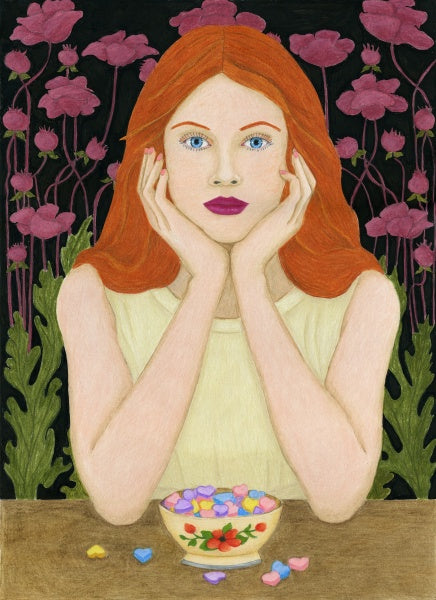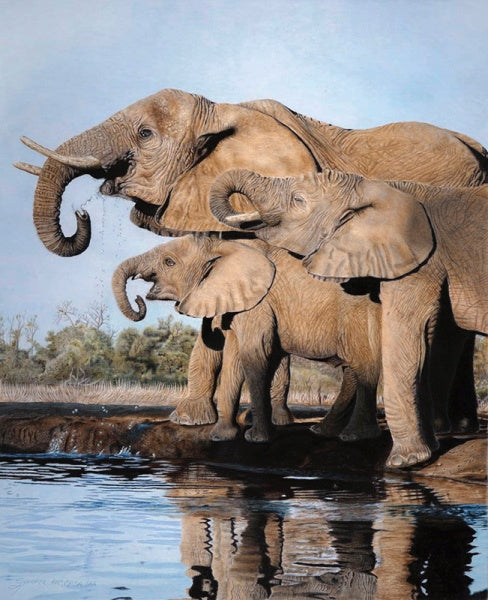Urban Wildlife Art: Where Cityscapes and Nature Converge
by Leah Gardner
Every artist has a reason they create. For me, art isn’t just about capturing moments—it’s about storytelling, exploring contrasts, and revealing connections. My passion for wildlife and fascination with urban environments shape my artistic vision, guiding me to create pieces that reflect a unique intersection of two worlds.
“400” portrays a captive Amur tiger, a stark reminder that only 400 remain in the wild. This piece highlights the fragility of their existence and the urgent need for conservation to protect one of the world’s most endangered big cats.
Finding Inspiration in the Unexpected
Wildlife and urban spaces collide in intriguing ways. As cities expand, animals adapt—navigating alleys, parks, and even rooftops. These encounters aren’t just fleeting moments; they’re powerful stories of resilience and adaptation. This dynamic is what I aim to capture in my art.
My creative process often starts with observation—taking in both natural and urban elements. I might see a fox weaving through a graffiti-covered alley or spot a pigeon perched on a rusting streetlamp. These real-life moments spark ideas, and I begin envisioning how to merge the raw energy of the city with the quiet, persistent presence of wildlife.
When I start a piece, I sketch compositions that juxtapose urban textures with animal forms—a deer caught in the glow of city lights, an owl surveying from atop a crumbling building. Colored pencils are my medium of choice because they allow me to build layers of color and detail gradually. The precision they offer means I can capture the subtle interplay of light on fur and the rough texture of brick. Each element holds symbolic weight: the graffiti represents human encroachment, while the animal embodies adaptability and endurance. The contrast between the natural and the man-made becomes a central theme, highlighting both tension and coexistence.
Colored Pencils: Bringing Detail and Depth
Working with colored pencils is both meticulous and rewarding. I love how they enable me to achieve vivid, lifelike colors and intricate textures, essential for capturing the nuances of wildlife in urban settings. For instance, when drawing a fox in an alley, I use rich, warm tones to depict the soft, dense fur, blending seamlessly into the muted, gritty backdrop of cracked pavement and faded paint. By layering colors and using fine strokes, I can achieve a realistic yet dynamic look, emphasizing how wildlife becomes almost camouflaged within human spaces.
“Hope” Amid crumbling landscapes, a single bee symbolizes resilience. Bees pollinate 75% of flowering plants but face habitat loss, pollution, and climate change. Protecting bees means safeguarding nature and our future.
The art challenges viewers to look closer, to notice what might be overlooked. The fine details—the glint in an animal’s eye, the weathered texture of a rusting street sign—invite a deeper connection, encouraging people to pause and reflect on the stories behind the image.
Blending Urban and Natural Worlds
Creating urban wildlife art is more than just placing an animal in a city setting. It’s about finding harmony between contrasting elements while maintaining authenticity. I carefully choose color schemes that bridge the vibrancy of urban graffiti and the subtle hues of fur or feathers. Textures are key—smooth, sleek surfaces juxtaposed against rough, worn city infrastructure.
One of my favorite pieces features a hare darting across cracked pavement, surrounded by faded street art. The dynamic movement of the hare contrasts with the static, decaying surroundings, hinting at the fleeting nature of both wildlife encounters and urban permanence. Capturing this contrast involves balancing the energy of the animal’s motion with the stillness of its environment—something that colored pencils make possible through their precision and layering capability.
“Solitude” Social by nature, yet many live alone—stolen from the wild, kept in captivity, or left in vanishing forests. Over 80% have been lost in a century. Deforestation, poaching, and the pet trade push them closer to extinction every day.
Symbolism and Storytelling Through Art
Symbolism is central to my work. A stag standing against a backdrop of neon signs might represent nature’s quiet defiance amid urban chaos. An owl perched on a rusted lamppost suggests wisdom persisting in neglected spaces. Through these choices, I aim to provoke thought—encouraging viewers to consider the stories that unfold when wildlife and urban life intersect.
By using colored pencils, I can meticulously render these scenes with a blend of realism and expression. Whether it’s the fine lines of feathers against a metal beam or the reflective glow of city lights on a deer’s coat, the medium allows me to convey the tension and coexistence between natural and human-made elements.
“I let the images speak for themselves”
Connecting Through Art
I don’t just create wildlife art; I explore the reality of animals living alongside us. I want my work to make people pause—to see the beauty, the struggle, and the subtle coexistence. My hope is that the art evokes curiosity and reflection, prompting a deeper awareness of how wildlife adapts to urban challenges.
While my art often carries an underlying message about conservation, it’s not always the primary focus. Instead, I let the images speak for themselves, capturing the resilience and quiet presence of animals in unexpected places. It’s about appreciating these encounters and recognizing that wildlife persists, even in the most human-dominated landscapes.
Art, for me, is about exploring the intersection of urban life and wildlife through color, detail, and composition. Using colored pencils allows me to capture the essence of these encounters—stories of survival and adaptation that challenge how we perceive both nature and our cities. Through my art, I invite viewers to see the familiar in a new light, appreciating the unexpected ways wildlife continues to find a place among us.
LEAH GARDNER:
A self-taught colored pencil artist, grew up in an animal rescue, fostering a deep love for wildlife. Her vibrant, detailed artwork captures the essence of animals while raising awareness of conservation issues. Through striking juxtapositions, Leah highlights the impact of human expansion on nature, inspiring a deeper connection between people and wildlife.
Facebook: Leah Gardner Art





Comments (8)
Wow Leah, a very detailed descriptive piece of writing, so very impressed. You should write a book. Well done, your art is amazing 👏 🤩 🤩💜🐾
Pawl SUTTON - Jun 16, 2025Known you for almost 30 years, I have seen your passion and love for the animal world grow into this wonderful talent you have for art, keep up the passion ❤️
Janet - Jun 16, 2025Great article Leah xx
Marge - Jun 16, 2025You bring the soul of the animal to life Leah. Incredible artwork.
Heather W - Jun 16, 2025A well thought out article which reveals your generous and sensitive personality.
Thérèse - Jun 16, 2025You have been my friend for years and your art has gone from strength to strength, fantastic blog post Xx
Karen Cole - Jun 16, 2025Leah it’s so interesting to have the artist’s descriptions of what they are trying to convey, makes you look at the piece again as to me it also adds depth.
Jackie Parsons - Jun 16, 2025Absolutely brilliantly written.
You never cease to amaze me, I have known you all of your life and you still keep finding ways to make me say how proud I am to call you my niece. I am as always so proud of you. Xx
Simon wragg - Jun 16, 2025